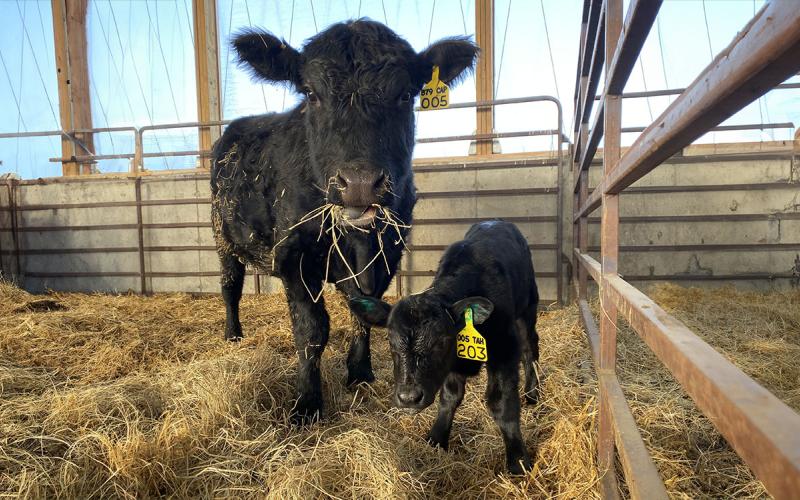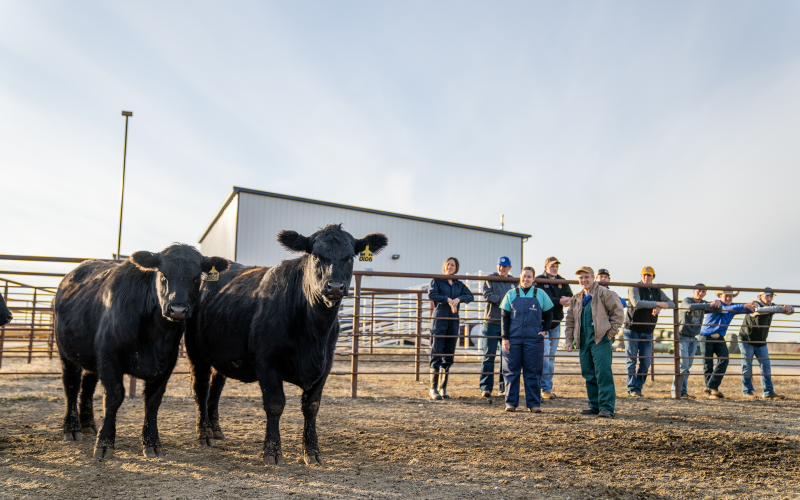Originally written by Olivia Amundson, former SDSU Extension Cow/Calf Field Specialist.
Whether the calving season will start soon or is a few months away, it’s never a bad time to start preparing for the arrival of fresh calves on the ground. Here are some things to consider prior to the beginning of calving.
1. Nutritional needs of the cow or heifer prior to calving.
The nutritional needs of a cow or heifer are important before and after calving. Nutrition is significant before calving due to the rapidly growing fetus, mammary regeneration and the synthesis of colostrum in preparation for lactation. Overfed and over conditioned cows however have the potential to struggle with dystocia due to accumulation of fat in the pelvis thus hindering fetal passage through the birth canal. Nutrition plays a large role in the duration of postpartum anestrous intervals, subsequent calving-to-conception interval and overall pregnancy rate. Two-year-old heifers and three-year-old cows are most vulnerable to nutritional needs during the last trimester due to continual growth of the dam and additionally the calf in utero. It is important to make sure these females are receiving adequate protein and energy during times of cold weather or available forage low in both protein and energy.
Body condition scoring (BCS) is also important as it impacts stamina during parturition, colostrum quality, calf vigor, and subsequent rebreeding. Recommended BCS for young and mature cows are 5 and 6 (scale 1-9), respectively. A common BCS system for beef cattle in the United States practice scores from 1-9, with 1 being emaciated and 9 being obese (Whitman, 1975).
2. Work with your veterinarian to review herd health plan.
If health issues within the herd have historically been an issue it’s important to review with your veterinarian any critical control points that could reduce risk.
3. Are calving facilities in working order?
In general, 9-10 months have passed since calving facilities were last used. Time saving strategies prior to calving include a walk-through of the calving setup, inspecting all gates, pens and alleys for any damaged or broken items. Make sure head catches and lighting are in working order.
Cleanliness prior and during calving is important to reduce spread of disease. If possible pressure-wash or steam-clean any hard surfaces in your calving facilities. Fresh bedding nearby can help keep the calf clean and prevent infections such as naval infections in a newborn calf.
4. Calving equipment and supplies.
It’s important to have multiple supplies on hand to assist during calving if necessary.
Things to have on hand:
- Disposable long-sleeve obstetrical (OB) gloves
- OB lubricant
- Paper towels
- Clean calf OB chains or straps and handles
- Calf-puller
- Halter and rope
- Oxytocin or epinephrine
- Iodine or chlorhexidine for disinfecting navel stumps
- Sterile syringes and appropriate sized needles
- Frozen colostrum or packages of colostrum replacer
- Esophageal feeder
- Electrolytes
- Tag box with tags and tag marker
- Bander and bands – if banding at calving
5. Review stages of parturition (calving) and when to intervene.
Understanding the different stages of parturition and when to intervene is important to the life of calf and health of the mother.
| Stage and Time | Event | External Signs | When to Intervene |
|---|---|---|---|
| I - Preparatory (2 to 6 hours) | Calf rotates to upright position Uterine contractions begin Water sac expelled | Restless, nesting, stops eating and drinking, vaginal discharge observed | More than 8 h, check for stillborn calves |
| II - Delivery (1 hour or less) |
Cow usually lying down Fetus enters birth canal Front feet and head protrude first Calf delivery complete | Abdominal straining 1-3x/min., water sac present, calf delivered | Water sac has been visible for 2 hours and not trying, no progress for more than 30 min, progress stops for more than 15 min |
| III - Cleaning (2 to 8 hours) |
“Button” attachments relax Uterine contractions expel membranes | Passes placenta | 12-24 h, check for retained placenta |
A normal delivery should be completed between two to three hours following the appearance of the water sac. It is important to make frequent observations to determine if assistance will be required.
6. Colostrum or colostrum replacement.
Colostrum is the first milk produced by a mother succeeding birth. This milk is high in nutrients and antibodies critical for the health of the calf. Colostrum can be frozen or commercially available. Calves need approximately 2 quarts of colostrum within four hours of birth and one gallon within 12 hours. Time becomes critical since only the newborn calf’s digestive tract allows antibodies to pass directly into the blood.
The most efficient way to provide initial colostrum to a calf is through suckling the dam, if the calf is unable, then other methods need to be considered to provide that first colostrum. Frozen colostrum from previous births or commercially available colostrum replacer is one other option. With frozen colostrum it is important to have it acquired from healthy cows to decrease disease transmission. Older cows generally provide higher quality colostrum than heifers. Indications of good quality colostrum include a yellow color with thick, creamy consistency.
Commercially available replacers are also something you may want to consider if you do not have access to fresh colostrum. Consulting your veterinarian for use of these supplements or replacers is recommended.
7. Cold weather and wind protection.
With most calves coming during the winter months here in the Midwest, it is important to have a plan to warm calves if born in frigid temperatures. Calves born in wet, cold conditions can quickly die to hypothermia. Colostrum warmed to body temperature along with drying the calf with towels and warm air can bring a calf with mild hypothermia’s (body temperature between 94 and 100°F) temperature back to normal. Calves dealing with extreme hypothermia can use a combination of warm colostrum and a warm bath. Prior to returning them to their mother, calves need to be dry, alert and maintain a normal body temperature.
Summary
A new year brings new opportunities. Each year cow/calf producers look forward to a healthy fresh calf-crop. Implementation of adequate calving facilities and equipment could set the stage for your best year yet. So, be proactive and began thinking about your calving season now!


